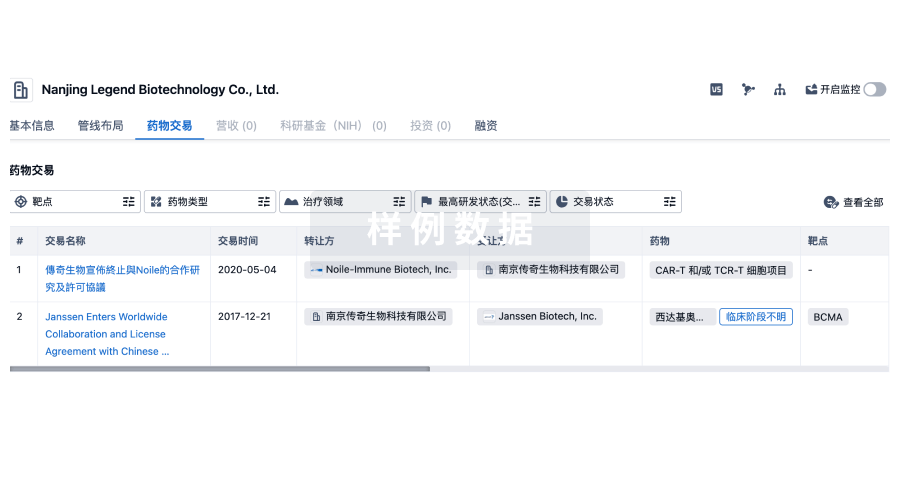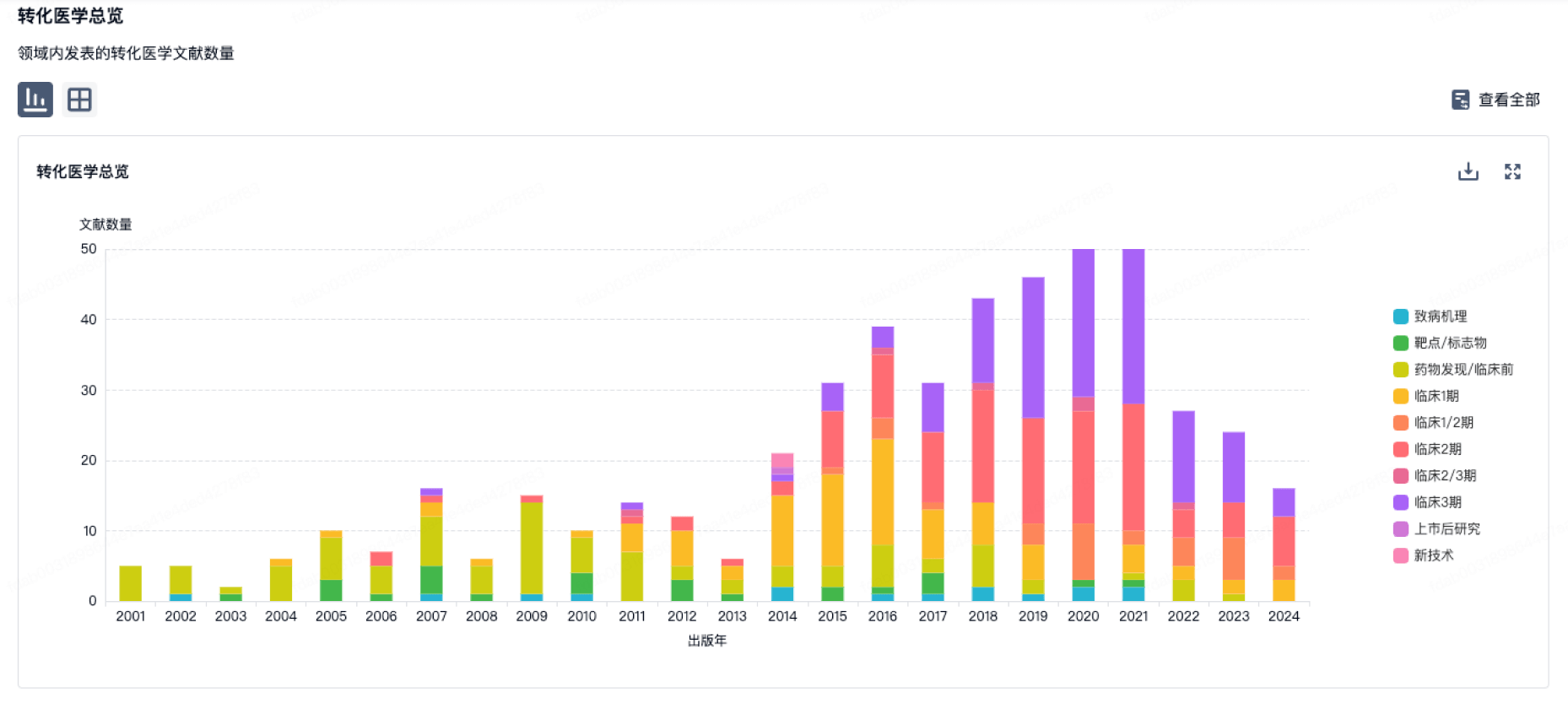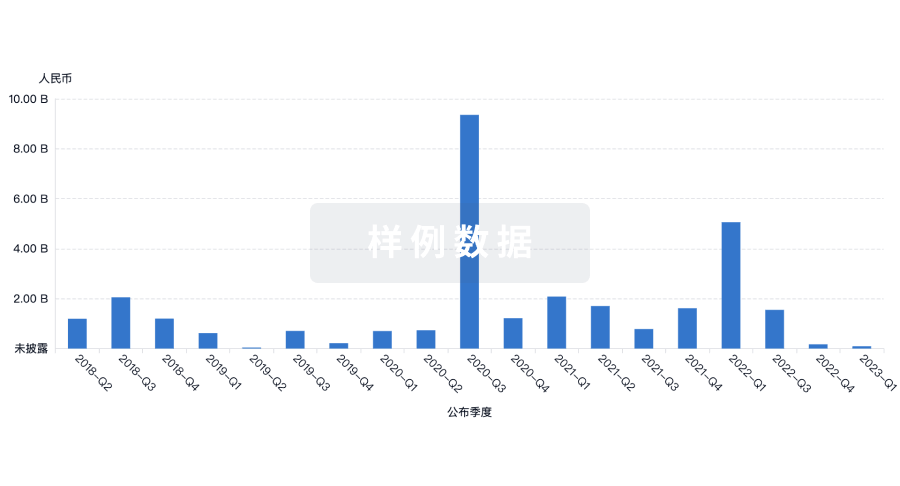预约演示
更新于:2025-12-07

University of Bern
更新于:2025-12-07
概览
标签
感染
心血管疾病
肿瘤
小分子化药
单克隆抗体
合成多肽
疾病领域得分
一眼洞穿机构专注的疾病领域
暂无数据
技术平台
公司药物应用最多的技术
暂无数据
靶点
公司最常开发的靶点
暂无数据
| 排名前五的药物类型 | 数量 |
|---|---|
| 小分子化药 | 8 |
| 合成多肽 | 2 |
| 单克隆抗体 | 2 |
| 非降解型分子胶 | 1 |
| 放射与诊断药物 | 1 |
关联
18
项与 University of Bern 相关的药物靶点 |
作用机制 CaN抑制剂 |
非在研适应症 |
最高研发阶段批准上市 |
首次获批国家/地区 美国 |
首次获批日期1983-11-14 |
靶点 |
作用机制 CB拮抗剂 |
原研机构 |
非在研适应症- |
最高研发阶段临床1期 |
首次获批国家/地区- |
首次获批日期- |
靶点 |
作用机制 VEGF-A抑制剂 |
在研适应症 |
最高研发阶段临床1期 |
首次获批国家/地区- |
首次获批日期- |
408
项与 University of Bern 相关的临床试验NCT05940662
Cost Effectiveness of Various Implant Placement Protocols in the Esthetic Zone - a Non-randomized Controlled Trial
Loss of teeth in the anterior upper jaw significantly affects both well-being and chewing function. Nowadays, dental implants are the treatment of choice for replacing missing teeth with fixed dental prostheses and are often placed in the anterior upper jaw.
Depending on various patient-related factors, protocols for the placement of dental implants involve the following time points after tooth extraction:
1. On the same day (immediate implantation)
2. After 1-4 months (early implantation)
3. After more than 4 months (late implantation).
The different treatment protocols have been investigated over long periods. The choice of the individually suitable treatment protocol for dental implantation depends on many factors and is of utmost importance in order to achieve the best possible treatment outcomes. Selecting an inappropriate treatment protocol would otherwise result in an increased risk of failure.
After decades of research and development in dental implantology, an expert association (International Team for Implantology, ITI) published an evidence-based decision management tool in 2022. This decision management tool assists dentists in choosing the individually suitable implant treatment protocol for single-tooth replacement in the upper jaw. A structured examination of the tooth to be extracted allows to classify the situation and select the most suitable treatment protocol for the individual situation. The treatment protocols differ in terms of time and material requirements, which are associated with different costs.
There is limited data about the cost-effectiveness of these treatment protocols. The present study aims to assess how the costs of the three treatment protocols differ in relation to treatment success.
Depending on various patient-related factors, protocols for the placement of dental implants involve the following time points after tooth extraction:
1. On the same day (immediate implantation)
2. After 1-4 months (early implantation)
3. After more than 4 months (late implantation).
The different treatment protocols have been investigated over long periods. The choice of the individually suitable treatment protocol for dental implantation depends on many factors and is of utmost importance in order to achieve the best possible treatment outcomes. Selecting an inappropriate treatment protocol would otherwise result in an increased risk of failure.
After decades of research and development in dental implantology, an expert association (International Team for Implantology, ITI) published an evidence-based decision management tool in 2022. This decision management tool assists dentists in choosing the individually suitable implant treatment protocol for single-tooth replacement in the upper jaw. A structured examination of the tooth to be extracted allows to classify the situation and select the most suitable treatment protocol for the individual situation. The treatment protocols differ in terms of time and material requirements, which are associated with different costs.
There is limited data about the cost-effectiveness of these treatment protocols. The present study aims to assess how the costs of the three treatment protocols differ in relation to treatment success.
开始日期2029-01-01 |
申办/合作机构 |
NCT04715542
Subcutaneous Stibium Metallicum Praeparatum 6x Versus Placebo in the PRevention Of PaclitaxEL-induced Peripheral NeurOTOXicity: the PROPEL NO TOX Randomized Controlled Trial
Chemotherapy induced peripheral neuropathy (CIPN) is one of the most limiting side effects of chemotherapy and often leads to adaptations in the protocol of the chemotherapy including dose reduction or even discontinuation of treatment. In general, the symptoms of CIPN are sensory, often distributed in a "stocking and glove" manner, and include pain, tingling, and numbness. CIPN has a marked negative influence on quality of life of patients and their families. It may result in serious limitations in daily functioning and affect the enjoyment, social relationships, and ability to perform work. Current management of CIPN (i.e. prevention and treatment) includes dose reduction or delay of chemotherapy cycles and treatment discontinuation. Unfortunately, this reduces the chance of an effective cancer treatment. Current guidelines of the American Society of Clinical Oncology (ASCO) on the Prevention and Management of Chemotherapy-Induced Peripheral Neuropathy do not conclusively recommend any agent for the prevention of CIPN. Due to the scarcity of drugs that are effective for preventing and treating CIPN, the distress of patients who suffer from CIPN, and the major societal and economic costs, new approaches and effective treatment strategies are required.
The proposed trial is a parallel, double blind, placebo controlled, randomised, phase III superiority trial, aiming to determine whether treatment with SMP prevents incidence of or reduces the severity symptoms of paclitaxel-induced peripheral neuropathy, as compared to placebo.
The proposed trial is a parallel, double blind, placebo controlled, randomised, phase III superiority trial, aiming to determine whether treatment with SMP prevents incidence of or reduces the severity symptoms of paclitaxel-induced peripheral neuropathy, as compared to placebo.
开始日期2026-08-01 |
申办/合作机构  University of Bern University of Bern [+5] |
NCT04817592
Characterization of the Corneal Biomechanics of Patients Treated by Corneal Lenticule Extraction for Advanced Refractive Correction (CLEAR) to Correct Myopia
This study aims to perform biomechanical tests on extracted CLEAR lenticles that are routinely discarded after surgery. The investigators also aim to perform Brillouin microscopy to get an in-vivo assessment of the patient's cornea preoperatively and to correlate this data with the postoperative characterization of the extracted corneal lenticule. The characterization will be done with established biomechanical and morphologic tests.
开始日期2026-06-01 |
申办/合作机构 |
100 项与 University of Bern 相关的临床结果
登录后查看更多信息
0 项与 University of Bern 相关的专利(医药)
登录后查看更多信息
44,443
项与 University of Bern 相关的文献(医药)2026-04-01·PARASITOLOGY INTERNATIONAL
Neospora caninum, Sarcocystis spp. and Toxoplasma gondii infections and their relationship with milk production in goats from Argentina
Article
作者: Arias, R O ; Moré, G ; Gortari Castillo, L ; Venturini, M C ; Steffen, K D ; Gos, M L
The apicomplexan protozoa Neospora caninum, Sarcocystis spp. and Toxoplasma gondii are worldwide distributed. Goat infections with these protozoans are frequent, although the relationship with milk production is unknown. The aim of this study was to evaluate and relate the antibodies titers to N. caninum, Sarcocystis spp. and T. gondii with the goat milk production. The study was conducted in two commercial dairy goat farms located in the province of Buenos Aires, Argentina. A total of 336 Saanen breed goats were evaluated (146 goats of E1 and 190 goats of E2). The total production per lactation was calculated and adjusted to 240 lactation days in milliliters. Blood samples obtained and the age, number of lactations, body condition, and FAMACHA© degree were recorded. Sera were tested for N. caninum, Sarcocystis spp. and T. gondii antibodies by IFAT, starting at 1:100 for N. caninum and T. gondii IFATs, and at 1:50 for Sarcocystis spp., and all three IFATs from each animal were processed at the same time to final titer. The overall seroprevalence of N. caninum, Sarcocystis spp. and T. gondii was 81.8 % (275/336), 85.1 % (286/336) and 66.7 % (224/336), respectively. Forty-nine percent (164/336) of goats were seropositive to three IFATs, 37.5 % (126/336) to two and 12.2 % (41/336) to only one. Similar N. caninum and Sarcocystis spp. seroprevalences were observed in E1 (80.1 and 88.4 %) compared to E2 (83.1 and 82.6 %), respectively. A higher T. gondii seroprevalence was detected in E1 (80.1 %) than E2 (56.3 %). A small group of 16 goats with higher IFAT titers to T. gondii, produced significantly less milk (85.3 L) than the rest. No significant milk productivity differences were found in goats seropositive and negative to only one, two or all three IFATs when analyzed within age and/or ordinal lactation number groups. Our results indicate a low association of seropositivity to these protozoans with goat milk production.
2026-03-01·International Orthodontics
Comparison of maxillary canine retraction using MBT™ versus Roth®. Prescriptions in young adult orthodontic patients: A split-mouth prospective clinical trial
Article
作者: Hussain, Umar ; Siddiqui, Sadaf ; Shah, Ahsan Mahmood ; Shaukat, Zartash ; Sakrani, Muhammad Hasnain ; Attique, Amir ; Pandis, Nikolaos ; Munir, Sundus ; Javed, Ambreen
BACKGROUND:
Shorter orthodontic treatment duration can minimize adverse effects. There is a lack of literature comparing McLaughlin, Bennett, and Trevisi (MBT™) and Roth® prescriptions on canine retraction rate.
OBJECTIVE:
To compare the rate of maxillary canine retraction between MBT™ and Roth® bracket prescriptions.
MATERIAL AND METHODS:
A split-mouth prospective clinical trial was conducted on 40 orthodontic patients over three months, requiring maxillary first premolar extractions. One side was bonded with MBT™ brackets and the contralateral side with Roth brackets. Leveling and alignment were completed with 0.017″×0.025″ stainless steel archwire. Canine retraction was initiated using sliding mechanics with nickel-titanium coil springs. Measurements were taken at 4, 8, and 12 weeks. Data were analyzed using linear mixed models.
RESULTS:
Mean age was 20.1(2.9) years, and 57.5% were female. MBT™ brackets demonstrated a significantly higher rate of canine retraction than Roth brackets. The mean differences in retraction rates at one, two, and three months were 0.2mm, 0.13mm, and 0.13mm, respectively (P<0.05). The total canine movement over three months was also significantly greater in the MBT™ group (mean difference: 0.45mm/month [95%CI: 0.32, 0.59]). On average, the rate of canine movement, after adjusting for time, was 0.16mm/month lower in Roth® compared to MBT™ (95% CI: -0.19, -0.12, P<0.001).
CONCLUSION:
MBT™ brackets facilitate a higher rate of canine retraction compared to Roth® brackets. MBT™ can used in cases requiring faster canine movement, while Roth® brackets may benefit from additional adjuncts to improve efficiency.
2026-03-01·ULTRASONICS
A comparative evaluation of two subharmonic-aided pressure estimation (SHAPE) analysis methods
Article
作者: Bosch, Jaume ; Vu, Trang ; Antonenko, Antonina ; Mayer, Hailee ; Machado, Priscilla ; Wallace, Kirk ; Dajti, Elton ; Forsberg, Flemming ; Berzigotti, Annalisa
Pressure measurement in clinical practice is a valuable tool for diagnostic evaluation, especially in diseases such as portal hypertension. Currently, portal pressures are measured by invasive hepatic vein catheterization, posing risks to patients, and limiting how often measurements can be obtained. Subharmonic-aided pressure estimation (SHAPE) is an ultrasound-based technique that leverages ultrasound contrast agents (UCAs) to estimate changes in hydrostatic pressure. UCAs act as nonlinear oscillators when exposed to high enough acoustic pressures (typically > 200 kPa) and produce significant energy components ranging from subharmonics to higher harmonics. Tissues do not generate significant subharmonic components, thus making it the optimal component for SHAPE. SHAPE is performed using subharmonic imaging complimented by an acoustic pressure optimization algorithm to induce the highest sensitivity to hydrostatic pressure in the UCAs. Traditionally, multiple acquisitions of contrast clips are used to identify the subharmonic amplitude and calculate SHAPE parameters, but recently, a faster method of SHAPE has been proposed, utilizing only the acoustic pressure optimization algorithm to obtain subharmonic amplitudes. The objective of this work is to compare the two methods, SHAPE and fast-SHAPE, in the same patients, to explore the utility of fast-SHAPE.
77
项与 University of Bern 相关的新闻(医药)2025-11-12
Colchicine, a cheap and widely used gout drug, may help prevent heart attacks and strokes in people with cardiovascular disease. Trials involving nearly 23,000 patients show meaningful reductions in risk with low doses. Side effects were mostly mild and short-lived. Researchers say this overlooked drug could become an accessible prevention tool pending further study.
A commonly used, low-cost medication for gout may help lower the chances of heart attacks and strokes in people with cardiovascular disease, according to a new Cochrane review.
Researchers evaluated the impact of taking small doses of colchicine, a standard gout treatment, and reported no rise in serious side effects.
Cardiovascular disease is often linked to long-term, low-level inflammation that increases the likelihood of repeat events such as heart attacks and strokes. Because colchicine reduces inflammation, it has emerged as a potentially useful option for people living with heart disease.
A promising effect on cardiovascular risk
The review assessed 12 randomized controlled trials that followed nearly 23,000 individuals with a history of heart disease, heart attack or stroke. Participants took colchicine for at least six months, usually at doses of 0.5 mg once or twice daily. About 80% of those enrolled were male (~80%), and their average age ranged from 57 to 74 years. Half received colchicine, while the rest were given either a placebo or no added medication on top of their typical care.
People taking low-dose colchicine experienced fewer heart attacks and strokes overall. For every 1,000 individuals treated, 9 heart attacks and 8 strokes were avoided compared with those who did not receive the drug. No serious adverse events were seen, although mild and short-lived stomach or digestive discomfort was more common among colchicine users.
"Among 200 people with cardiovascular disease -- where we would normally expect around seven heart attacks and four strokes -- using low-dose colchicine could prevent about two of each," says Dr. Ramin Ebrahimi, co-lead author from the University Medicine Greifswald, Germany. "Reductions like this can make a real difference for patients who live with ongoing, lifelong cardiovascular risk."
A new use for a long-established medicine
Since cardiovascular diseases remain the leading cause of death worldwide, colchicine offers a potentially affordable and widely available strategy for preventing additional heart problems in high-risk patients.
"These results come from publicly funded trials repurposing a very old, low-cost drug for an entirely new use," says Lars Hemkens, senior author from the University of Bern, Switzerland. "It shows the power of academic research to reveal treatment opportunities that traditional drug development often overlooks."
Questions still remain about whether colchicine influences overall mortality or reduces the need for procedures such as coronary revascularization. The trials also did not determine whether the drug improves quality of life or shortens hospital stays. The authors emphasize that more research is required to address these gaps.
临床结果AHA会议
2025-11-03
当一枚微小的放射性探针注入人体,它便如同一枚精准制导的“生物导弹”,悄然深入病灶核心,不仅让癌细胞在影像中无处可藏,更能从内部精准摧毁肿瘤——这正是核医学在精准医疗时代所展现的强大潜力。
近日,2025年欧洲核医学协会年会(EANM 2025)圆满落幕,一系列领域内突破性成果集中发布。在众多前沿研究中,两类靶向探针——FAPI与PSMA,以其广泛的临床适用性和卓越的诊疗一体化表现,再次成为会议瞩目的焦点。这些进展不仅推动了肿瘤诊断技术的迭代,更标志着“诊疗一体化”模式正系统性地重塑癌症治疗的未来格局。
在此背景下,2025年10月29日晚,由中国人体健康促进会主办的“放射性示踪剂临床实践训练营(第六期)”在线上成功举办。会议特邀首都医科大学附属北京天坛医院艾林主任、樊迪副研究员,以及湖南省肿瘤医院郑凯主治医师,围绕本届EANM年会的最新科研与临床进展,展开了深入解读与交流。
会议主席艾林主任指出,该系列培训班历经五届持续举办,已逐步构建起系统化的核医学临床实践交流体系,本次课程聚焦于欧洲核医学协会年会(EANM)的前沿动态,旨在通过三位讲者从不同维度的专业解读,将国际最新研究成果与临床实践深度融合。会议期待通过这种专题化的学术交流,为参会医师的临床决策与科研创新提供理论依据和方法学参考。
前沿、融合、展望:欧洲核医学年会2025年放射性药物研究热点解析
首都医科大学附属天坛医院樊迪副研究员聚焦于第38届欧洲核医学年会(EANM 2025)的前沿动态。她指出,本届大会作为欧洲核医学协会40周年庆典,云集了9431名专家,接收摘要近3000篇,全面展示了领域的创新前沿。放射性药物的迅猛发展是会议核心议题,其进展凸显了三大关键趋势:靶点选择的多元化、诊疗一体化的深入推进以及新型核素的探索应用,共同构成了未来发展的核心范式。
在新型靶点探索上,中国团队表现尤为突出。武汉大学中南医院的一项研究,采用一种新型镓-68标记的环状三聚体探针,特异性靶向上皮来源恶性肿瘤中高表达的整合素αvβ6。在一项纳入58名非小细胞肺癌患者的前瞻性临床试验中,该探针诊断准确率达到惊人的100%;在与¹⁸F-FDG的头对头比较中,其在检测脑转移灶方面展现出更优的敏感性,并成功改变了其中14名(24.1%)患者的临床治疗方案。
另一明星靶点FAP(成纤维细胞活化蛋白)的研究同样精彩纷呈。国内团队利用¹⁸F-FAPI-04探针评估狼疮性肾炎,发现FAP阴性患者的完全缓解率高达89%,显著优于FDG,为疾病评估提供了全新无创手段。在治疗领域,镥-177标记的FAP靶向药物在难治性实体瘤中显示出可控毒性及良好疾病控制率;更有大规模研究采用镥-177与锕-225两种核素标记的FAP抑制剂,跨越285个治疗周期,在24种晚期实体瘤中证明了其卓越的肿瘤靶向性与疗效。
纵观整场会议,从针对前列腺癌新靶点ACP3的诊疗一体化探索,到将TSPO传统神经探针创新性应用于压力超负荷心肌病的动态演变监测,无不彰显着核医学正以前所未有的深度与精度,推动精准医疗迈向新纪元。这些突破性进展,标志着放射性药物研发已进入一个靶点更多元、诊断更精准、治疗更高效的全新时代。
18F-FAPI-04在复发性分化型甲状腺癌诊断中的应用
在本届EANM中,湖南省肿瘤医院郑凯主治医师带来的一项口头汇报研究,为精准诊断提供了新锐视角。该研究系统性地揭示,FAPI PET-CT在检测特定类型的癌症转移灶方面,展现出远优于传统FDG PET-CT的敏锐洞察力。
研究旨在系统评估FAPI PET-CT相较于FDG PET-CT在特定患者群体中的病灶检出能力。通过对2021年12月至2023年11月期间纳入的23例患者(中位年龄42岁,男性3例、女性20例;乳头状癌22例,滤泡状癌1例)进行回顾性分析,研究团队重点比较了两种影像学方法在检测转移病灶方面的诊断效能。
研究结果显示,FAPI PET-CT共检测到19个病灶,其中包括7例颈部淋巴结转移、5例肺转移、4例骨转移,以及腹壁转移结节和局部复发灶各1例。尤为值得注意的是,7个经术后病理证实的颈部淋巴结转移灶平均直径仅为5.9±1.4毫米,这些亚厘米级病灶均未被传统影像学方法(包括超声、增强CT及FDG PET-CT)检出,而仅由FAPI PET-CT成功识别。
在定量分析方面,FAPI显像中恶性病灶的最大标准化摄取值(SUVmax)和靶本底比(TBR)均显著高于良性病变,而FDG显像则未显示此差异。在诊断性能方面,FAPI在病灶水平的敏感性和准确性分别达到75%和80%,显著优于FDG的13%和27%;在患者水平,FAPI更实现了100%的敏感性,准确性达88%,明显高于FDG的14%和56%,且所有差异均具有统计学意义。
这些发现通过典型病例的影像学对照得到进一步验证,直观展示了FAPI PET-CT在检测微转移病灶方面的独特优势,特别是在传统影像方法难以识别的亚厘米级淋巴结转移诊断中表现出卓越的临床价值。
EANM 2025前沿进展深度解析
EANM 2025公布的研究数据不仅证实了现有探针的临床价值,更揭示了多个突破性的发展方向,展现了核医学从诊断到治疗的全面革新。
01
FAPI探针:从肿瘤成像到疾病微环境监测的跨越
FAPI探针在心脏疾病领域的突破性应用令人瞩目。英国牛津大学Kennedy风湿病研究所的M. Coles团队首次系统评估了FAPI PET/CT在心肌纤维化疾病中的诊断价值。研究显示,在肥厚型心肌病患者中,FAPI摄取程度与心脏磁共振测得的纤维化体积呈显著正相关(r=0.82,p<0.001)。这意味着FAPI成像有望成为无创评估心肌纤维化的新方法,替代部分侵入性心肌活检。更值得注意的是,研究发现在急性心肌炎患者中,FAPI信号在症状出现后7天内即显著升高,早于传统影像学改变,为早期诊断和干预提供了宝贵的时间窗口。
英国爱丁堡大学BHF心血管科学中心的N. Craig团队的肺部疾病研究同样带来惊喜。在特发性肺纤维化患者队列中,[68Ga]Ga-FAPI-04 PET/CT显示的病灶范围与传统高分辨率CT具有良好一致性,但在活动性病灶检测方面展现出独特优势。研究数据显示,FAPI PET在识别需要治疗的活动性纤维化病灶时,灵敏度达到92.3%,特异性87.6%,显著优于传统影像。这一发现可能改变肺纤维化的治疗监测策略,实现更精准的靶向治疗。
比利时布鲁塞尔Jules Bordet研究所的Anne-L. Deleu团队的风湿性疾病应用研究开创了自身免疫疾病影像评估的新维度。在类风湿关节炎患者中,FAPI信号强度与疾病活动度评分、血清炎症标志物水平显著相关。更重要的是,研究发现FAPI成像能够识别临床前期的关节病变,在关节肿胀和疼痛出现前3-6个月即可检测到FAPI信号升高。
02
PSMA探针:从治疗效果到作用机制的深度探索
德国图宾根大学J. Schwenck团队采用全转录组测序技术,深入解析了[177Lu]Lu-PSMA-617对前列腺癌细胞的分子层面影响。研究发现,除了预期的DNA损伤反应通路激活外,治疗还显著影响了代谢重编程相关基因、自噬启动和完成相关基因及多个免疫检查点分子的表达。这些发现不仅解释了PSMA靶向放疗的作用机制,更为联合治疗策略的设计提供了分子基础。例如,自噬通路的激活提示联合自噬抑制剂可能增强治疗效果。
新加坡国立大学Q. Wu团队的创新性在于将靶向放疗与代谢调节相结合。研究团队发现,转酮醇酶抑制剂B-OT通过以下机制增强[177Lu]Lu-PSMA-617疗效:①核苷酸合成阻断:降低肿瘤细胞内dNTP池水平,削弱DNA损伤修复能力;②氧化应激增强:减少NADPH生成,降低抗氧化防御能力;③能量代谢障碍:干扰磷酸戊糖途径,影响ATP生成。在动物模型中,联合治疗组相比单药治疗组,肿瘤生长抑制率从45.2%提升至78.9%(p<0.01),且未增加毒性反应。这一研究为克服放疗抵抗提供了全新的思路。
03
新型探针与创新应用
瑞士伯尔尼大学医院核医学科E. Gourni团队的双价FAPI分子设计通过将两个FAPI配体通过优化长度的连接子连接,成功实现了亲和力提升,与单价FAPI相比,Kd值从6.3 nM改善至1.2 nM;肿瘤滞留延长,4小时肿瘤摄取保持初始水平的85%,而单价仅为62%以及药代动力学优化,肾脏清除加快,肾脏滞留减少。在45例多种实体瘤患者的初步研究中,[68Ga]Ga-DOTAGA-PEG2-Glu(FAPI)显示出优异的诊断性能,特别是在传统[18F]FDG PET显像不佳的肿瘤类型中。
荷兰鹿特丹伊拉斯姆斯医学中心S. U. Dalm团队首次系统比较了[177Lu]Lu-FAP-2286与[161Tb]Tb-FAP-2286的治疗效果差异。研究显示,尽管两种制剂在生物分布方面相似,但由于铽-161释放的转换电子和俄歇电子的高线性能量转移特性,[161Tb]Tb-FAP-2286在体外实验中显示出更强的细胞杀伤效应。特别是在小肿瘤病灶(直径<3mm)的治疗中,[161Tb]Tb-FAP-2286组的完全缓解率达到66.7%,显著高于[177Lu]Lu-FAP-2286组的33.3%。
04
探针原理:精准锁定病灶的"导航系统"
FAPI探针靶向的是成纤维细胞活化蛋白,这种蛋白在超过90%的上皮源性肿瘤周围的癌相关成纤维细胞中高表达。FAPI探针通过与FAP特异性结合,实现对肿瘤微环境的精准成像,而非仅仅针对肿瘤细胞本身。这一特性使其具备了广谱抗癌成像的潜力。PSMA探针则瞄准前列腺特异性膜抗原,这是一种在前列腺癌细胞表面过度表达的跨膜蛋白。尤其是在去势抵抗性前列腺癌中,PSMA表达水平显著上调,使其成为理想靶点。PSMA探针已成为前列腺癌诊疗的不二利器。
"诊疗一体化" 探针的核心价值在于使用同一种靶向分子,当标记诊断性核素(如镓-68)时用于PET/CT成像;当标记治疗性核素(如镥-177)时,则变身"肿瘤杀手",精准递送辐射至癌组织。
05
技术突破:从实验室到临床,从“手工作坊”到“智能工厂”
制备工艺的精进使得放射性探针实现了高效、稳定的放射性标记。以FAPI探针为例,研究人员已开发出双价FAPI分子,通过增加结合位点,显著提升了肿瘤摄取率和滞留时间。PSMA探针则从最初的PSMA-11发展到如今的PSMA-I&T和PSMA-617,药代动力学特性不断优化,肿瘤杀伤效果持续增强。
在核医学诊疗一体化的进程中,自动化合成模块的应用是一场静默却深刻的技术革命。这些看似简单的金属盒子,实则是精密编程的"智能工厂",正在彻底改变放射性探针的制备方式。
从人工操作到全自动化的跨越实现了质的飞跃。传统放射性探针制备需要技术人员在厚实的铅屏蔽后,凭借熟练手法完成每一步操作,不仅对操作人员是巨大考验,更因人为因素存在产品批次间差异的风险。
现代自动化合成模块通过预编程的合成程序,将复杂的化学过程封装在紧凑的系统内。
如今,不仅18F-FDG可以使用整合一体式卡套,实现一键式高效稳定合成,随着技术进一步发展,如18F-PSMA、18F-FAPI等新型探针的制备,从前体化合物与18F的混合、加热反应到最终的纯化灭菌,整个过程也实现了在封闭系统中自动完成,操作人员只需"一键启动",即可实现高重复性高通量生产,极大地加速了新探针从研发到临床应用的转化进程。研究人员开发出新探针分子后,可以快速将其整合到标准化的自动化制备流程中,大大缩短了技术成熟周期。
质量控制的飞跃是自动化最显著的优势。模块通过精确控制反应温度、时间、pH值等关键参数,确保每一批次产品都具有一致的放射化学纯度和生物学性能。研究显示,自动化制备批次间放射化学纯度差异可控制在1%以内,远优于手动制备的5-10%波动。
辐射安全的重要保障同样不可忽视。自动化模块集成了厚重的铅屏蔽,工作人员在制备过程中接受的辐射剂量可降低至手动操作的十分之一以下。这种"隔墙操作"模式,让核药学工作人员告别了厚重的个人防护装备,大大改善了工作环境。
标准化与可追溯性是自动化的另一大亮点。符合药品生产质量管理规范的要求,系统自动记录每个制备批次的完整数据,包括反应参数、纯度检测结果等,为产品质量提供了完整的追溯链条。
特别值得关注的是,新一代合成模块普遍采用一次性无菌套件,彻底消除了交叉污染的风险。从反应瓶、纯化柱到最终产品收集瓶,所有与药液接触的部件均为无菌单次使用,确保了产品的无菌保障水平。
06
68Ga药物引领创新,固体靶技术奠定未来⁶⁸Ga生产的革命性突破
核医学药物研发正沿着“靶点创新、分子优化与应用跨界”三条路径高速推进。作为欧洲核医学年会持续的关注焦点,68Ga标记药物的前沿进展依然是本届会议的核心亮点,68Ga药物已超越“一种显像剂”的范畴,它已成为连接基础发现、技术创新与临床转化的核心桥梁,持续引领着核医学精准诊疗的未来。
在靶点层面,Nectin4(OP-018)作为一个新兴靶点脱颖而出,中国武汉协和医院团队开发的[68Ga]Ga-NOTA-HA22不仅在显像中展现出高肿瘤摄取,其相应的[177Lu]标记治疗药物在模型中也实现了显著的肿瘤抑制,构成了一个极具潜力的新型“诊疗对”。在分子形式上,双特异性分子成为优化药代动力学的关键策略,例如伯尔尼大学团队的双价FAPI探针(EPS-013),通过结构设计将亲和力提升了一个数量级,并显著延长了肿瘤滞留时间。在应用边界上,药物正突破疾病类型的束缚:北京协和医院的[68Ga]Ga-NY104(OP-066)将PSMA成像成功应用于肾透明细胞癌的术前诊断;而多项研究共同证实,FAPI探针已成为评估心肌纤维化、肺纤维化和类风湿关节炎等纤维化与炎症性疾病的有力工具。此外,针对c-Met的纳米抗体(EPS-006)、靶向CD73的小分子抑制剂(EPS-019)以及基于 bicyclic peptide 的BCMA靶向剂(EPS-014)等一系列新型探针,共同标志着核医学的药物管线正变得前所未有的丰富和多元化,为精准诊疗提供了日益强大的武器库。
而固体靶技术作为实现其临床转化与规模化应用的关键推动力,其重要性同样不言而喻。值得特别关注的是,固体靶技术在68Ga生产中的应用正在彻底改变核素供应格局。与传统液体靶相比,固体靶技术具有显著优势:
产量突破性提升:固体靶系统可生产高达10GBq级别的68Ga活性,是传统液体靶的5-10倍。这一突破使得单个中心能够满足大批量临床需求,甚至支持多中心研究项目。
核素纯度卓越:固体靶产生的68Ga具有更高的放射性核纯度,金属杂质含量显著降低。这对于敏感的前体化合物标记至关重要,特别是像FAPI这类对金属杂质敏感的新型探针。
新型探针开发的推动者:高活度的68Ga供应为双价或多价FAPI分子的临床转化提供了可能。这些新型探针通常需要更高的放射性投入才能获得足够的比活度,固体靶技术正好满足这一需求。
国内多家顶尖医疗机构已经开始部署固体靶68Ga生产线,预计将在未来两年内实现规模化应用,这将大大降低68Ga标记探针的生产成本,提高可及性。固体靶与自动化合成的协同效应正在显现。固体靶提供高质量、高产量的68Ga供应,而自动化合成模块确保标记过程的标准化和可重复性,两者结合为核医学诊疗一体化提供了坚实的技术基础。
这一技术组合特别适合中国国情,能够在不依赖进口发生器的情况下,建立自主可控的放射性药物供应体系,为更多患者提供高质量的核医学诊疗服务。
核医学的精准诊疗时代已经到来。随着FAPI、PSMA等先进探针从研究走向临床,从单一应用走向全面覆盖,医生们手中拥有了更为精准的"武器"。而自动化合成模块和固体靶技术作为可靠的技术后盾,确保这些尖端成果能够安全、标准、经济地服务于每一位患者。
未来,当患者确诊癌症时,接受的或许不再仅仅是传统的手术或化疗,而是一系列基于特异性分子探针的精准诊断与靶向放射治疗——更高效、更个体化、副作用更小的医疗正在成为现实。
本视频/资讯/文章的内容不能以任何方式取代专业的医疗指导,也不应被视为诊疗建议。医脉通是专业的在线医生平台,“感知世界医学脉搏,助力中国临床决策”是平台的使命。医脉通旗下拥有「临床指南」「用药参考」「医学文献王」「医知源」「e研通」「e脉播」等系列产品,全面满足医学工作者临床决策、获取新知及提升科研效率等方面的需求。
放射疗法
2025-10-20
2025年欧洲肿瘤内科学会年会(ESMO)于10月17日至21日在柏林举行,多项肿瘤领域前沿研究结果在会上公布。宫颈癌仍是当前严重威胁女性健康的疾病,尽管早期患者预后有所改善,但复发或转移性宫颈癌(r/mCC)的治疗效果仍不理想,临床面临严峻挑战。目前r/mCC一线治疗普遍采用化疗联合免疫及抗血管生成药物,然而一旦治疗失败,二线选择有限,疗效普遍欠佳,亟需新的治疗策略。抗体偶联药物(ADC)在后线治疗中已显示出潜力,其联合策略有望为当前治疗格局带来突破。
本次大会上,中山大学肿瘤防治中心郑敏教授、顾海风教授团队发布了AK001研究的最新随访结果。该Ⅱ期研究探索了卡度尼利单抗联合维迪西妥单抗或白蛋白紫杉醇治疗r/mCC的疗效与安全性。《肿瘤瞭望》特邀郑敏教授、顾海风教授深入解读该研究进展,并邀请中山大学孙逸仙纪念医院林仲秋教授进行专业点评。
Q
《肿瘤瞭望》
郑敏教授,首先请您结合临床实践经验及相关研究进展,谈谈近年来宫颈癌精准诊疗领域有哪些核心突破进展及挑战?
郑敏教授:
宫颈癌精准诊疗领域近年来取得了显著突破,主要体现在三大方面:
免疫治疗全线前移,联合策略成为基石
首先,免疫治疗已经从后线推进到一线,彻底重塑了治疗格局。KEYNOTE-826这一里程碑研究证实,在持续性、复发性或转移性宫颈癌中,“化疗+抗血管生成+免疫检查点抑制剂”策略能显著改善患者的总生存期(OS)和无进展生存期(PFS),这使得该联合方案成为宫颈癌领域全球一线标准治疗方案,实现了从控制病情到显著延长生命的跨越。
ADC精准靶向引领免疫治疗升级
抗体偶联药物(ADC)凭借其精准靶向特性,在个体化治疗中展现出重要价值。其中,我国自主研发的维迪西妥单抗(RC48),2024年美国肿瘤学会(ASCO)年会上公布的C018研究显示,在HER2表达阳性(IHC 1+~3+)的二线及以上复发转移性宫颈癌患者中,该药表现出卓越的单药活性和可控的安全性,不仅验证了HER2作为治疗靶点的潜力,也为化疗和免疫治疗失败的患者提供了全新的“中国方案”,极大丰富了治疗选择。
治疗新趋势:精准前移与协同联合
当前治疗策略也呈现出前移与联合的趋势。大量研究正探索将免疫治疗前移至局部晚期宫颈癌的同步放化疗中,以期提高根治率。同时,“ADC+免疫”的联合策略成为研究热点,旨在克服耐药、提升疗效。2024年国际妇科肿瘤学年会(IGCS)上我们团队汇报的“爱卡研究”(AK001研究)显示,维迪西妥单抗联合卡度尼利单抗在二线及以上患者中ORR高达50%,突破了既往治疗瓶颈,且安全性可控。
精准时代的挑战与未来方向
尽管取得显著进展,我们仍面临诸多挑战。首先是一线强效联合方案下依然存在的原发与继发耐药问题,破解肿瘤异质性和免疫微环境抑制等耐药机制是突破疗效天花板的关键。其次是生物标志物的精准应用和临床推广不足,如何合理组合PD-L1、TMB、MSI-H以及TF、HER2、TROP2等标志物以实现最佳疗效和最低毒性仍在探索中,且基层医院HER2、PD-L1检测覆盖率低导致部分患者错失精准治疗机会。第三是药物可及性与毒副反应的平衡问题,创新药物费用高昂,免疫相关不良事件和ADC独特毒性(如眼毒性、间质性肺炎)对临床医生的全程管理能力提出更高要求,我们需要建立更完善的随访和管理体系,确保患者既能“用得上药”,也能“用得好药”。最后,对于宫颈胃型腺癌等特殊病理类型,因其对传统放化疗不敏感且常不伴HPV感染,开发有效治疗方案仍是未来重点。
总结来说,我们正处在一个充满希望的时代,ADC药物等创新策略为宫颈癌患者点亮了新的生命之光。但前路依然漫长,未来的方向将更加聚焦于:深化机制研究以克服耐药、探索更佳的生物标志物以实现精准分层、优化联合治疗策略以提升疗效、并加强全程化管理以保障患者安全与生活质量。作为临床医生,我们既是这些变革的见证者,也是积极的参与者和推动者,我们的最终目标是让每一位宫颈癌患者都能获得最适合她的个体化精准治疗。
Q
《肿瘤瞭望》
AK001研究的最新数据刚刚在今年ESMO大会上公布,顾海风教授,作为研究Key Sub-I,能否请您简要介绍下开展该研究的背景、具体的研究方案,以及本次数据更新的主要内容?
顾海风教授:
复发转移性宫颈癌的二线治疗目前在NCCN指南中尚无标准方案,总体而言,这类患者单药治疗效果不佳,亟需探索更有效的联合治疗方案,这也是我们开展“爱卡研究”(AK001研究)的初衷。
研究背景:以ADC+免疫突破二线困境
近年来,ADC药物在多种实体瘤中取得显著进展。其精准靶向肿瘤细胞的能力,不仅提高治疗有效性,也显著降低对正常组织的毒性。其中,维迪西妥单抗是我国自主研发的靶向HER2的ADC药物,同时也是首个获得美国食品药品监督管理局(FDA)和中国药品监督管理局突破性疗法双重认定的ADC药物。C018研究结果显示,维迪西妥单抗单药在HER2表达的一线治疗失败后复发转移宫颈癌中,ORR达36.4%,中位PFS为4.37个月。卡度尼利单抗是首个获批上市的国产双特异性抗体,也是全球首款PD-1/CTLA-4双抗,既往研究显示在既往化疗失败的复发或转移性宫颈癌患者中,卡度尼利单抗单药展现了良好的疗效以及安全性可耐受。目前,在其他瘤种研究中已观察到ADC药物与免疫治疗的协同作用,能够提高整体治疗效果并改善患者耐受性,这为复发转移性宫颈癌的治疗带来新希望。
研究方案:双队列设计,聚焦精准人群
基于以上背景,AK001研究应运而生。该研究是一项前瞻性、双队列、多中心、开放标签的II期临床试验,由中山大学肿瘤防治中心郑敏教授团队牵头。研究根据患者HER2表达情况设计两个队列。其中,队列一纳入了74例既往接受过1-3线化疗的HER2表达阳性复发性或转移性宫颈癌患者,既往研究表明HER2表达阳性患者通常预后更差、治疗更困难,本队列采用维迪西妥单抗联合卡度尼利单抗,期望发挥ADC与免疫双抗的协同作用,实现“1+1≥2”的疗效提升并降低毒副反应。队列二纳入了42例HER2阴性患者,,接受卡度尼利单抗联合白蛋白紫杉醇治疗。主要研究终点为ORR,次要终点包括疾病控制率(DCR)、PFS、OS、缓解持续时间(DoR)及安全性数据。
数据更新:疗效持续,协同效应凸显
在2024年IGCS大会上,我们初步报道了24例患者的基线数据、抗肿瘤活性及安全性数据。本次ESMO会议上,入组患者例数扩充至45例,其中队列一24例,中位随访时间显著延长至9.8个月。在基线数据方面,我们详细展示了年龄、组织学类型、HER2表达水平、既往治疗线数、贝伐珠单抗使用情况、免疫治疗史、放疗史及PD-L1 CPS评分等。在更大样本中,队列一中HER2低表达(IHC 1+)患者占比达79.2%;此外,既往接受过免疫治疗的患者在队列一中占33%,这些是本次基线数据的重要特点。
在肿瘤治疗活性方面,队列一的ORR和DCR分别为50%和90.9%。特别值得注意的是,队列一出现3例完全缓解(CR)患者,占比13.36%。在样本量显著增加和随访时间显著延长的情况下,本次更新数据与IGCS大会数据相比基本保持稳定,体现了“爱卡组合方案”强效、稳定和持久的特点,并且两组的中位PFS、OS及DoR目前尚未达到,这也给我们研究团队带来更强信心,未来能更好地完成这项研究。
在安全性数据方面,本次以列表形式详细展示了两组的安全性数据,其中3-4级不良反应发生率两组分别为13.5%和19.0%,显示了较好的安全性。我们还展示了一例完全缓解患者靶病灶治疗前后对比的CT图像,以帮助领域同道更直观理解研究结果。
Q
《肿瘤瞭望》
郑敏教授,基于AK001最新数据,请您谈谈您如何看待双特异性抗体与ADC药物联合治疗复发转移性宫颈癌的协同潜力?
郑敏教授:
维迪西妥单抗和卡度尼利单抗的联合并非简单叠加,而是构建了一个强大的正向免疫循环。
协同机制:ADC精准引导免疫升级
首先,维迪西妥单抗通过靶向HER2精准杀伤肿瘤细胞,并诱导免疫原性细胞死亡和释放新抗原,将缺乏T细胞浸润的“冷”肿瘤转变为充满免疫细胞的“热”肿瘤,为免疫治疗准备了“战场”并激活T细胞。其次,卡度尼利单抗同时阻断PD-1和CTLA-4这两个关键免疫抑制信号,使活化的T细胞得以大量增殖、高效浸润肿瘤组织并充分发挥杀伤功能。最后,被T细胞杀死的肿瘤细胞进一步释放更多抗原,持续激活新一轮免疫应答,形成不断自我放大的抗肿瘤免疫正向循环,从而产生“1+1>2”的协同效应和持久疗效。
更新数据印证协同潜力与广度
本次ESMO更新数据在中位随访9.8个月后显示,队列I(维迪西妥单抗+卡度尼利)的ORR仍稳定在50.0%,CR达13.6%,其中1例持续完全缓解,多数病例取得持续缓解,证明了该联合方案协同作用的持续性。特别值得注意的是,队列I中79.2%的患者为HER2低表达(IHC 1+),仍能实现高ORR与CR,这突破了传统HER2靶向药仅适用于HER2 表达ICH 2+/3+人群的限制,显著扩展了获益人群范围。此外,本研究未排除既往接受免疫治疗的患者,更新数据中这类患者占比达1/3,而总体ORR仍达50%,提示ADC联合免疫治疗策略基于其精准靶向的优势有望为免疫单抗治疗失败的患者提供新的选择,这也是本研究的一个重要优势,相关亚组分析结果我们将在后续公布。
Q
《肿瘤瞭望》
在临床用药中,“疗效”和“安全性”需平衡,尤其是r/mCC患者身体耐受性较差。顾海风教授,请您结合AK001研究更新数据,谈谈针对AK001研究相关不良反应,您团队在研究中或后续临床应用时,会采取哪些具体管理策略?
顾海风教授:
针对“爱卡研究”(AK001研究)在临床中常见的不良反应,我们团队在研究过程中及后续临床应用中,已形成一套系统性、前瞻性的管理策略。
维迪西妥单抗相关不良反应管理
周围神经病变是常见不良反应,源于其搭载的MMAE抗微管作用。我们加强预防和早期监测,在治疗前对患者进行基线神经系统评估,并在每个周期主动询问有无感觉异常。常规采用10mg地塞米松作为激素预处理,可显著降低神经毒性发生风险。对于已出现的1–2级周围神经病变,常使用B族维生素、甲钴胺等对症治疗,并进行生活方式指导,如避免接触过冷/过热物体、穿着宽松软鞋以防足部损伤。对于≥3级者,立即启动多学科协作,必要时请神经内科会诊,并根据指南和经验进行剂量调整(延迟给药或减量),加强支持治疗,多数患者症状可缓解。
血液学毒性(如贫血、中性粒细胞减少)亦较常见。我们在每个治疗周期前常规检查血常规,密切监测指标变化。对于3级贫血,根据症状决定是否输血,并应用促红素及铁剂;对于3–4级中性粒细胞减少,按指南预防性或治疗性使用粒细胞集落刺激因子,必要时联用抗生素以降低感染风险。数据显示,通过积极干预,绝大多数血液学毒性可控可逆。
肝功能异常主要通过定期监测肝功能进行跟踪。对异常者酌情使用护肝药物(如甘草酸制剂、谷胱甘肽等),并排除其他肝损伤原因。实践中,肝功能异常多为1–2级,经保肝治疗后可恢复,未见严重肝损伤。
卡度尼利单抗相关不良反应管理
尽管本次更新中免疫相关不良事件不突出,但由于卡度尼利同时靶向PD-1与CTLA-4,我们始终对其潜在风险保持高度警惕,并遵循标准化管理路径:第一,重视预防,治疗前全面检查基线内分泌功能、甲状腺功能等;第二,加强患者教育,告知需警惕的免疫相关症状(如皮疹、腹泻、乏力、咳嗽、气促等);第三,按指南进行规范处理,备有详尽的免疫相关不良事件预案,一旦发生,严格按分级管理原则,使用糖皮质激素或免疫抑制剂干预,确保患者安全。
总结来看,我们认为维迪西妥单抗联合卡度尼利单抗为复发转移性宫颈癌患者提供了一个疗效与安全性高度平衡的治疗选择。其安全性特征可概括为:首先,严重不良反应发生率较低,特别是3~4级治疗相关不良事件发生率低,患者耐受性良好;其次,不良反应谱系熟悉,源于两种药物的已知特性,临床医生具备相对成熟的管理经验;第三,通过前瞻性监测和标准化干预,绝大多数不良反应可防、可控、可缓解,不致造成不可逆的治疗中断,从而保障疗效最大化。我们有信心将该联合方案的安全性置于可控框架内,并相信“爱卡方案”有望成为HER2表达阳性复发转移性宫颈癌患者新的后线治疗基石,兼具希望与安全性。
Q
《肿瘤瞭望》
2025年ESMO年会,AK001研究更新数据为ADC药物联合免疫治疗在复发性或转移性宫颈癌领域临床实践再添例证,郑敏教授,您认为这些发现将如何影响未来的临床实践?基于目前的成果,下一步的研究方向会重点探索哪些问题?
郑敏教授:
AK001研究在2025年ESMO公布的更新数据确实令人鼓舞,正从多个层面逐步重塑复发转移性宫颈癌的治疗格局。
引领二线治疗走向“精准联合、去化疗”新时代
首先,它为宫颈癌二线治疗提供了一种全新且强有力的“去化疗”选择。我们知道,过去对于复发转移性宫颈癌患者,传统细胞毒化疗仍占据重要地位,但其有效率低、毒副反应大,效果不尽人意。但AK001研究展示的‘ADC药物+免疫治疗’模式,以其卓越的疗效和可控的安全性,为二线治疗提供了一个新的选择。未来,我们也期望在这一组合能够成为指南推荐的新的治疗选项之一。
其次,该方案显著扩大了抗HER2治疗的适宜人群。数据显示约80%的HER2表达宫颈癌患者为低表达(IHC 1+),而本研究证实这部分患者同样能获得满意疗效,这与乳腺癌中仅限HER2高表达(IHC 2+及以上)的传统认知形成对比,对临床实践意义重大。
第三,其为一线免疫治疗后进展的人群提供了再次使用免疫双抗的循证医学证据。目前紫杉醇+顺铂+免疫检查点单抗±贝达珠单抗已经成为复发晚期宫颈癌的标准治疗。而目前多数二线研究排除此类患者,而AK001研究显示在这类人群中仍能取得高ORR,展现了应对免疫耐药潜力的重要优势。
未来研究的重点方向:从协同机制到精准前移
基于现有成果,我们下一步研究将重点聚焦于如下几个方向:首先,最核心的是探索最佳获益人群,我们将利用二代测序、空间转录组学等前沿技术寻找能精准预测疗效和毒性的生物标志物,构建完善的预测模型。同时我们计划将治疗线数前移,探索“爱卡方案”用于晚期宫颈癌一线治疗的潜力,以期在保证疗效的同时降低毒性,提高患者生活质量。其次,优化组合策略以破解耐药也至关重要,我们将在“ADC+免疫”基础上审慎探索联合其他药物(如抗血管生成药物)以期进一步提升疗效,并深入开展耐药机制的基础研究。此外,随着该方案可能成为标准治疗,我们需要通过大规模真实世界研究密切关注其长期安全性和对患者生活质量的影响。
总之,AK001研究为我们打开了ADC联合免疫双抗治疗复发转移性宫颈癌的大门,不仅有望改变现有治疗模式,也指明了未来研究的方向,即更加精准、更早干预、更智慧地联合用药,我们对未来的研究充满期待。
郑敏 教授
中山大学附属肿瘤医院 妇科 主任医师 教授
博士生导师 博士后合作导师 宫颈癌大PI
中国抗癌协会第一届宫颈癌专业委员会委员
国家卫健委能力建设和继教中心肿瘤CTIT全程管理专家组成员华南肿瘤学国家重点实验室学术委员会委员、国自然基金评审专家 广东省老年保健协会理事、机器人妇科肿瘤学分会主委广东省临床医学学会肿瘤学分会副主委广东省妇幼保健协会妇科肿瘤专业委员会副主委广东省健康管理协会妇科肿瘤专业委员会副主委广东省医学会机器人外科协会委员、妇瘤学组副组长 曾留学欧美近十年,取得瑞士苏黎世大学和伯尔尼大学双医学博士学位。主持多项国家自然科学基金面上项目及省,市重点项目研究,连续五次获得国自然面上项目资助在国内、国际知名期刊发表近百篇文章 (JCI, JAMA Oncology, et al) 作为第一或通讯作者在Cell Reports Medicine, JITC, Theranostics等国际知名期刊发表56篇文章擅长妇科肿瘤开腹、微创、机器人手术连续十多年来荣获医院手术、门诊量贡献奖,曾获岭南名医、羊城好医生等奖
顾海风 教授
中山大学附属肿瘤医院
中山大学肿瘤防治中心妇科副主任医师、肿瘤学博士
硕士研究生导师、住院医师规范化培训全程导师
擅长妇科恶性肿瘤的手术、化疗和综合治疗
近年于国内外知名期刊发表第一/通讯作者文章 18篇,其中SCI论文 13篇,所发表论文被欧洲妇科肿瘤学会(ESGO)、美国妇科肿瘤学会(SGO)等著名国际指南累计引用9次。主持国自然、省自然、市科技项目各一项,持有国家实用新型专利2项,指导在读研究生2名。学术任职:广东省老年保健协会机器人妇科肿瘤专业委员会常委兼秘书广东省临床医学学会肿瘤学专业委员会委员广东省妇幼保健学会妇科肿瘤专业委员会委员广东省药学会妇科肿瘤专业委员会委员广东省科技厅自然基金评审专家2026年ESGO年会审稿专家、2024年ESGO子宫内膜癌指南国际外审专家
大咖点评
林仲秋教授
宫颈癌仍是严重威胁女性健康的恶性肿瘤。近年来,虽然早期患者的预后获得改善,但复发转移性宫颈癌(r/mCC)的治疗效果仍不理想,成为临床实践中的主要难点。目前,r/mCC的一线治疗多依托于化疗联合免疫治疗及抗血管生成药物,然而一旦治疗失败,后续二线方案选择有限,疗效难以令人满意,亟需开拓新的治疗路径。
在此背景下,抗体偶联药物(ADC)与免疫治疗的联合被视为有希望的选择。AK001研究作为该领域代表性探索,首次系统评估了国产ADC维迪西妥单抗与双特异性抗体卡度尼利单抗联合用于复发宫颈癌二线治疗的潜力。在2025年ESMO公布的数据显示该方案ORR 达50%、CR达 13.6%,且在HER2低表达人群中同样有效。
该方案的可能机制是:维迪西妥单抗通过精准杀伤与免疫原性死亡,重塑肿瘤微环境;卡度尼利单抗继而解除免疫抑制、放大T细胞应答,形成正向抗肿瘤循环。该方案在HER2低表达人群中也展现出疗效,突破了传统HER2靶向治疗需要高表达的人群局限,为包括免疫治疗进展者在内的难治患者提供了新希望。在安全性方面,研究团队通过预处理、分级管理与多学科协作,有效控制了不良反应,使该方案兼具强度与可控性。
尽管成果令人鼓舞,宫颈癌精准诊疗仍面临一系列挑战:一线耐药问题尚待解决,生物标志物检测可及性不足,药物可及性与长期管理仍需体系化努力,胃型腺癌等特殊亚型也缺乏有效方案。
未来,研究应致力于深化生物标志物探索、推动有效方案前移、并积极探索逆转耐药的联合策略。AK001研究为r/mCC二线治疗提供了新的选择。
林仲秋 教授
中山大学二级教授、一级主任医师、首届名医,博士研究生导师
孙逸仙纪念医院妇产科教授
澳门医学专科学院院士、澳门镜湖医院妇产科顾问医师
中国抗癌协会宫颈癌专业委员会主任委员
中国医师协会整合医学分会妇产科专业委员会副主任委员
中国初级卫生保健基金会妇科专业委员会副主任委员
中国医药教育协会妇科肿瘤医学教育委员会副主任委员
人卫出版社全国统编教材临床医学专业《妇产科学》第6,10版编委、第7-9版副主编,高教出版社成人教育《妇产科学》主编,《宫颈癌手术技巧图解》、《外阴癌2024林仲秋观点》、《逸仙妇瘤化疗手册》、《逸仙妇瘤诊治流程》、《逸仙妇瘤围手术期处理》、《宫颈腺癌诊治规范和病例精解》、《宫颈癌患者指导手册》等30多部医学专著主编或总主编。
(来源:《肿瘤瞭望》编辑部)
声 明
凡署名原创的文章版权属《肿瘤瞭望》所有,欢迎分享、转载。本文仅供医疗卫生专业人士了解最新医药资讯参考使用,不代表本平台观点。该等信息不能以任何方式取代专业的医疗指导,也不应被视为诊疗建议,如果该信息被用于资讯以外的目的,本站及作者不承担相关责任。
抗体药物偶联物ASCO会议临床结果临床2期免疫疗法
100 项与 University of Bern 相关的药物交易
登录后查看更多信息
100 项与 University of Bern 相关的转化医学
登录后查看更多信息
组织架构
使用我们的机构树数据加速您的研究。
登录
或

管线布局
2025年12月19日管线快照
管线布局中药物为当前组织机构及其子机构作为药物机构进行统计,早期临床1期并入临床1期,临床1/2期并入临床2期,临床2/3期并入临床3期
药物发现
5
12
临床前
临床1期
1
7
其他
登录后查看更多信息
当前项目
| 药物(靶点) | 适应症 | 全球最高研发状态 |
|---|---|---|
Abicipar pegol ( VEGF-A ) | 湿性黄斑变性 更多 | 临床1期 |
GSK-7975-A ( ORAI1 x SARAF ) | 自身免疫性疾病 更多 | 临床前 |
Thiolato-bridged dinuclear ruthenium(II)-arene compound 5 | 侵袭性肺炎链球菌感染 更多 | 临床前 |
SYT-510 ( CB ) | 创伤后应激障碍 更多 | 临床前 |
SLN-140 ( PROS1 ) | 血友病 更多 | 临床前 |
登录后查看更多信息
药物交易
使用我们的药物交易数据加速您的研究。
登录
或

转化医学
使用我们的转化医学数据加速您的研究。
登录
或

营收
使用 Synapse 探索超过 36 万个组织的财务状况。
登录
或

科研基金(NIH)
访问超过 200 万项资助和基金信息,以提升您的研究之旅。
登录
或

投资
深入了解从初创企业到成熟企业的最新公司投资动态。
登录
或

融资
发掘融资趋势以验证和推进您的投资机会。
登录
或

生物医药百科问答
全新生物医药AI Agent 覆盖科研全链路,让突破性发现快人一步
立即开始免费试用!
智慧芽新药情报库是智慧芽专为生命科学人士构建的基于AI的创新药情报平台,助您全方位提升您的研发与决策效率。
立即开始数据试用!
智慧芽新药库数据也通过智慧芽数据服务平台,以API或者数据包形式对外开放,助您更加充分利用智慧芽新药情报信息。
生物序列数据库
生物药研发创新
免费使用
化学结构数据库
小分子化药研发创新
免费使用



